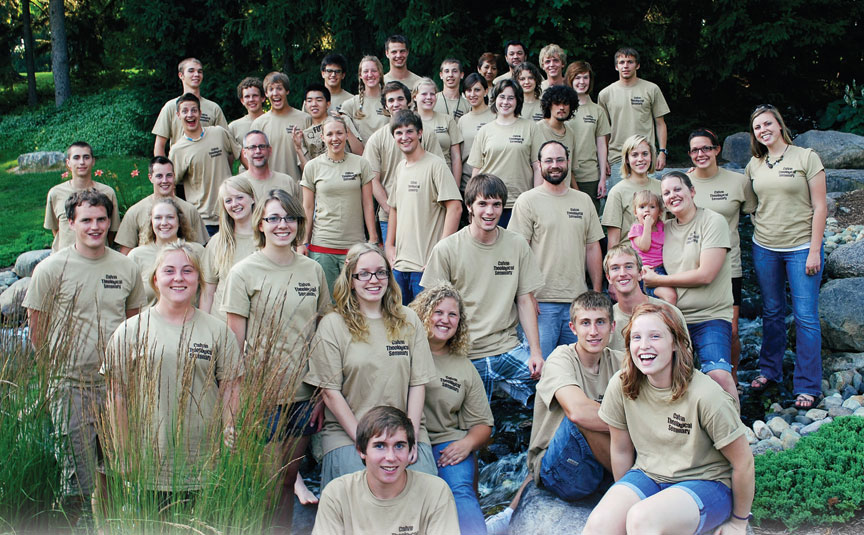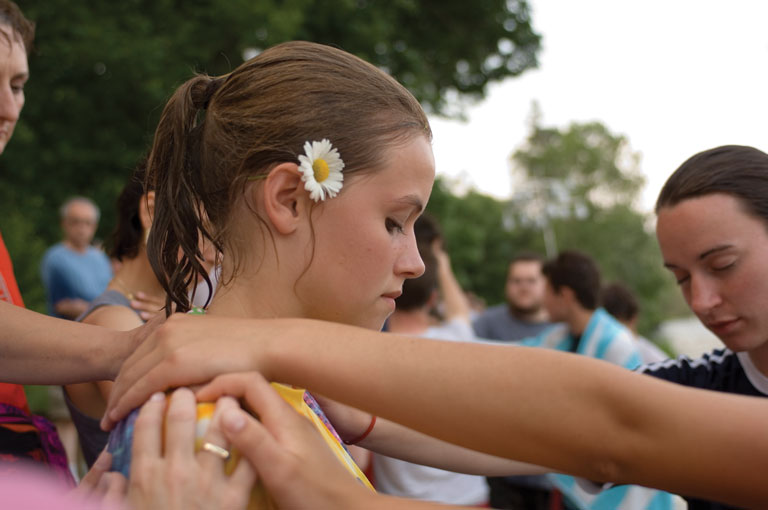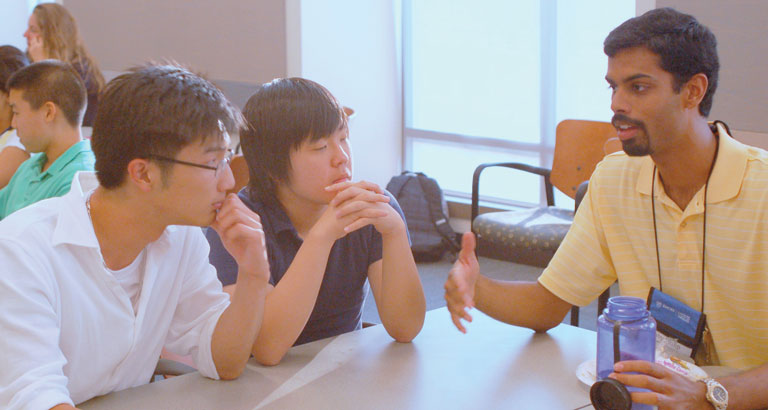 |
| This summer, 34 high school students attended the Facing Your Future program at Calvin Theological Seminary. If trends continue, 40 percent may eventually pursue vocational ministry or nonprofit service. |
When donors to Candler School of Theology gathered recently to hear from members of the faculty, Dr. Brent Strawn's topic prompted a few smiles. "I called it ‘What I've learned from high school students about teaching the Bible,'" says Strawn, an Old Testament scholar and veteran professor in the master of divinity program.
He wasn't joking. Three years ago he volunteered to teach at Candler's Youth Theological Initiative (YTI), a summer academy that brings 36 teenagers to campus for three weeks of intense study. He used the opportunity to reshape familiar material into fresh packages that would appeal to a younger audience. The results were so successful that he now includes the YTI presentations in the "Introduction to Old Testament" course he teaches at the graduate level. The lectures work well for both groups because the generation gap is closing. "The average age for Candler students has dropped to 25 years or so," estimates Strawn. At the same time, YTI participants are carefully selected for their maturity and eagerness to tackle serious subjects. "We call them ‘scholars' and we try to treat them that way."
Candler's YTI program dates back to 1993 when the campus served as the test site for an idea initiated by Lilly Endowment Inc. that envisioned new possibilities for engaging young people in religious life. Teens have many opportunities to attend computer camps, debate camps and music camps, but where can they learn theology?
"Some of these kids are taking quantum physics in high school, but they're getting fourth-grade theology at church," says Carol Lytch, assistant executive director of the Association of Theological Schools. Lytch is an In Trust board member who teaches at the Summer Youth Institute at Pittsburgh Theological Seminary. "When students have the capacity to think deeply about complex issues, it's important for us to give them the resources to do it."
In 1998, the success of Candler's Youth Theological Initiative prompted Lilly Endowment to launch a national project called "Theological Programs for High School Youth." Within three years, 48 theological schools — including Catholic, mainline Protestant, and evangelical Protestant institutions - had received grants to launch programs that reached out to teenagers and took them beyond traditional church camp or vacation Bible school activities. The hope was that students would benefit from their interaction with scholars, and scholars would benefit from their communication with teens. Candler served as a model, but it quickly became obvious that one size didn't fit all.
"There are a lot of ways to do this," says Jeff Kaster, director of the Youth in Theology and Ministry program at Saint John's School of Theology-Seminary in Minnesota. "This initiative has raised the idea that high school youth can engage in theological thinking, which youth ministry too often has abdicated in favor of personal spirituality, community building, and social fun. This program is saying, ‘Hey, you know what? Young people are smart, so let's get them to think about God in serious ways.' The results can be wonderful, and seminary is the place where it can happen."
Thinking beyond enrollment
Among the hoped-for results, of course, is that youth may eventually enroll in the theological school that introduced them to the idea of professional ministry. Campus administrators are optimistic but realistic about that possibility. They know it's a long shot, since much can happen in the gap between high school and college graduation. "If a school wants to develop a feeder program, it should probably work with college students," suggests Beth Corrie, director of Candler's YTI. The goal that has emerged after a decade of program implementation is more selfless: to help expand and enrich the pool of future seminarians, knowing that many degree candidates will take their tuition dollars elsewhere.
"What has been interesting is that as the initiative has developed, schools have become more and more clear about why they are participating in it," says Chris Coble, the Lilly Endowment program director who has overseen the initiative since its launch. "They're seeing themselves not just as graduate schools but as centers of learning that are working with young people and laity to develop leaders for the entire church."
Schools that are comfortable with this broader mission have been pleased with program outcomes. Lytch believes that participating seminaries have become more attuned to the way the younger generation thinks. This has shifted their pedagogical approaches to the point that they're "getting better at capturing the 30-and-under age group that we had lost."
The long-term effects could be widespread. Research indicates that 20 percent of the 11,000 program alumni are headed for some kind of Christian service. As an example, of 224 students who completed college after participating in the Summer Youth Institute at Pittsburgh Theological Seminary, 42 have gone on to graduate theological work, and a dozen of them have studied at Pittsburgh.
Statistics are even higher at Calvin Theological Seminary, where 35 high school juniors and seniors arrive on campus each July. Greg Janke, director of Calvin's Facing Your Future initiative, maintains contact with program graduates through phone calls, e-mails, and surveys. He estimates that 40 percent of Facing Your Future youth eventually pursue vocational ministry or opt for careers in nonprofit ministry organizations. More good news: "Of the 20 percent who go into direct ministry, 80 percent come back to Calvin for their training," says Janke.
Schools measure the impact of their programs in different ways. Last year, participants in the Youth in Theology and Ministry program at Saint John's School of Theology-Seminary responded to the same question two times, once before they experienced the program and again after they completed the curriculum. The question — "Would you consider studying theology in the future?" — received twice as many "yes" answers at the conclusion of the program than it did at the beginning. That was encouraging to the 18 partners, some of them small religious orders and communities, that help fund the initiative each year.
"Recruiting for religious life right now is challenging," says Jeff Kaster, director of Saint John's program. "And recruiting within the Catholic context for the priesthood is really challenging. If we keep doing the same things, we'll keep getting the same results. We have to think creatively about how we prepare and call people to ministry in the new millennium. One thing that seems to be working is to take the long-term view and engage students in high school rather than wait until they're out of college. It's a radical idea, but I think something radical needs to happen."
 |
| The Youth in Theology and Ministry program at Saint John's School of Theology-Seminary operates with this premise: "Young people are smart, so let's get them to think about God in serious ways." |
How youth programs can succeed
Of the original grantees in the Theological Programs for High School Youth initiative, 24 schools received renewal grants last year to fine-tune their efforts and develop ways to achieve financial sustainability. The schools that have ended their programs have done so for a variety of reasons. Some had trouble tapping into networks that would identify outstanding youth and guide them to seminary campuses. "Theological schools don't have natural connections with high school youth, so they have to build partnerships to develop those connections," says Coble. "The strongest programs figured out how to do that."
Other schools treated their youth programs as add-ons rather than integral parts of who they are and what they do. "It's hard for schools to add something that seems tangential to their mission," says Carol Lytch, who coordinated all of the seminary-based high school programs when she worked for the Fund for Theological Education. "When resources are tight, as they certainly are now, schools tend to want to focus more closely on their mission [preparing graduate students for ministry] and not go for the wider view." Lytch cites four factors that can help seminary-based youth programs succeed.
-
The sponsoring school must "own" the project by bringing faculty and staff in on the planning and implementation.
-
The host campus needs to have key partnerships in place to ease the workload and share the financial burden.
-
The content of the program needs to be truly challenging so it complements rather than duplicates the Christian formation that teens experience at camp and in their youth groups.
-
Each program needs to be a work in progress, always subject to evaluation and improvement.
"I've been active in our program since 1996 and I've seen the evolution," says Beth Corrie at Candler. "After every summer session, we do serious soul-searching and look for ways to improve it. We make adjustments as youth culture changes, as society changes, and as we come to understand the way young people learn. We include some new staff each summer so we always have fresh voices around the table to challenge us."
 |
| At Candler School of Theology, participants in the Youth Theological Initiative are called "scholars" and the program draws on the resources of the school's top faculty members and graduate students. |
Learning is a two-way process on most of the campuses. At Candler, graduate students study the program as they simultaneously work and teach in it. Their research becomes part of dissertations on religious education and youth ministry. At Saint John's, seminarians who are working on master's degrees in pastoral ministry earn credit for acting as adult mentors. At Calvin, seminarians are "live-in leaders" who guide participants through the program and facilitate small groups. Some of these seminarians are interested in youth ministry, but most are considering some sort of parish ministry. Working in the program gives them hands-on experience.
"Over time, many schools have linked the youth programs more closely with the core missions of the schools," says Coble. "One way to do that is to get their master's student more involved. The youth programs become laboratories for interacting with high school-age students."
Building sustainability
Schools that are determined to sustain their youth programs beyond the grant period have taken steps to curb costs without jeopardizing impact. Programs that once included an international travel component have settled on destinations closer to home. At least one program requires each participant's home congregation to cover part of the tuition as a way of expanding the program's network of stakeholders.
Candler has cut the length of its summer academy from four weeks to three and has trimmed the number of participants from 48 to 36. Students used to pay a nominal $75 deposit; this summer's fee is $1,000. Because the cost per scholar is $5,500, Beth Corrie continues to look for savings. This is a challenge because she is determined to achieve a diverse enrollment, and she estimates half of this year's students will receive scholarships. "Housing and feeding people for three weeks is expensive," she admits. "It might be cheaper if we were to go to a camp, but then we wouldn't have the academic emphasis. One of our core elements is a commitment to learning, and here we draw on the resources of top-rate theological minds."
Saint John's youth program has created an endowment to help meet the goal of being self-sustaining by 2018. Participants pay $425 for the two-week experience, but the actual cost is $1,800 per youth. The religious communities that serve as vocational partners have been generous, and "we're going to get youth more engaged in fundraising as part of their leadership projects," says Jeff Kaster.
Churches in Grand Rapids take turns bringing dinner to participants in Calvin's Facing Your Future program, a tradition that creates opportunities for adult-youth interaction. When teams of students leave for their 10-day ministry excursions, they carpool instead of flying to sites as far away as New Jersey. Such belt-tightening measures help bridge the gap between what participants pay ($300 per student) and what the program costs ($3,000 per student). Greg Janke, a pastor who is director of enrollment at Calvin Theological Seminary in addition to his duties as director of the school's Facing Your Future program, sees the value of the youth program from all vantage points.
"I think the church absolutely has to continue focusing on youth and targeting those who are going to be the next generation of leaders," he says. "We need to be exploring the way seminaries can be facilitators to make that happen. It has to be a priority. By the time kids get to college, most of them have made up their minds and are moving in other directions."
A sample of high school youth programs
Associated Mennonite Biblical Seminary www.ambs.edu/explore
Calvin Theological Seminary www.calvinseminary.edu/fyf
Candler School of Theology yti.emory.edu
Catholic Theological Union www.peacebuildersinitiative.org
Duke University Divinity School www.divinity.duke.edu/initiatives-centers/youth-academy
Gordon-Conwell Theological Seminary www.gordonconwell.edu/resources/High-School-Students.cfm
Lancaster Theological Seminary www.lancasterseminary.edu/academics/continuing-education/youth
Pittsburgh Theological Seminary www.summeryouthinstitute.org
Saint John's School of Theology-Seminary www.csbsju.edu/sot/ytm
What to ask before your administrators apply for grants
At Saint John's School of Theology-Seminary, "the design of [a grant] proposal is an administrative function, but the board endorses the proposal before it's submitted," explains the school's dean, William J. Cahoy. "The board's specific involvement usually depends on scale and timing. The scale is not only a matter of the grant's size, but also of how much it may affect our mission."
To ensure broad support for a grant initiative, many requests for proposals — such as those for the Theological Programs for High School Youth — require the signatures of the school's chief executive officer, chief financial officer, and board chair. Questions for board members to consider before pursuing any grant opportunity include:
-
Is the grant program germane to our school's mission?
-
What are our specific goals and objectives for the program?
-
How will we measure outcomes?
-
If the program is successful, can we sustain it after the funding period?
-
What new partnerships will this program foster?
-
How will participation affect our existing programs?
-
What will be the impact on our faculty and staff?
-
Will the grant-funded program strengthen relationships with key constituents such as alumni, donors, students, and parent church or denomination?
-
Will the program raise the visibility of our seminary in positive ways?
-
What will we — board members, administrators, faculty and staff — learn from this program?